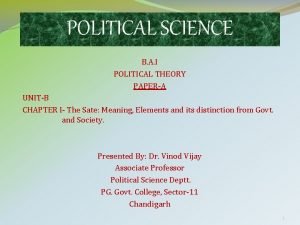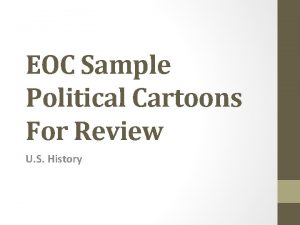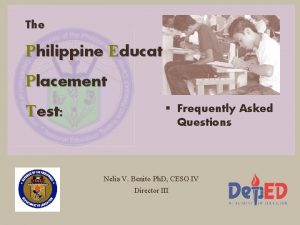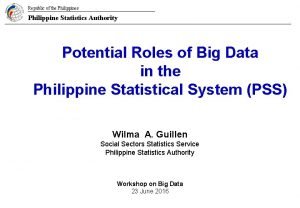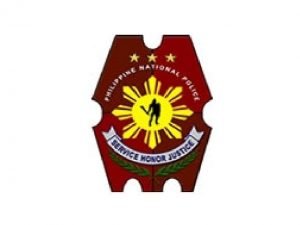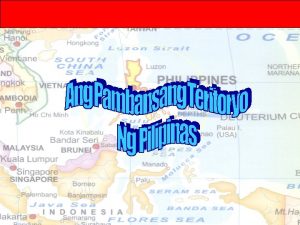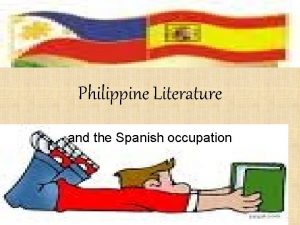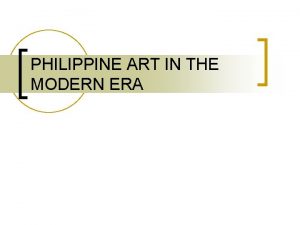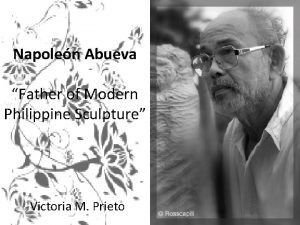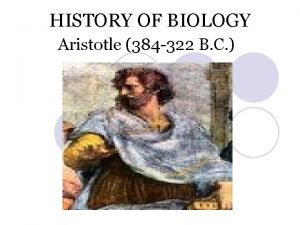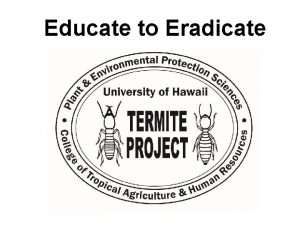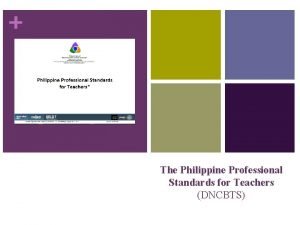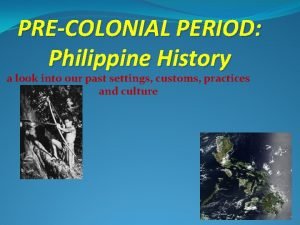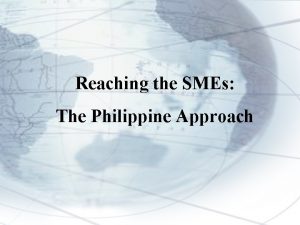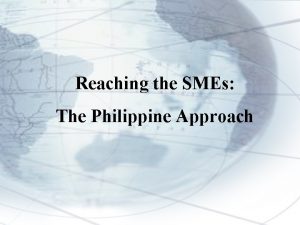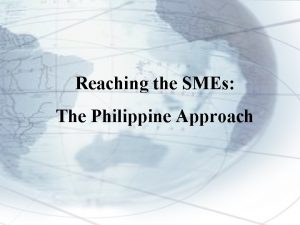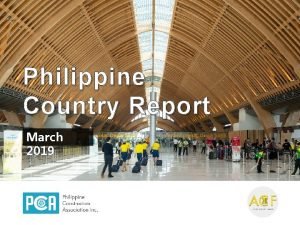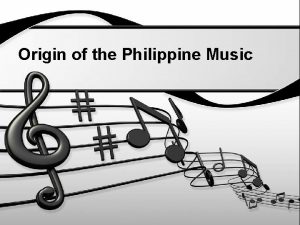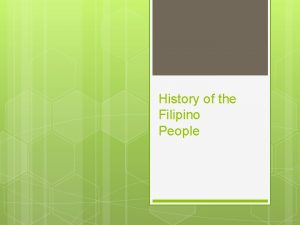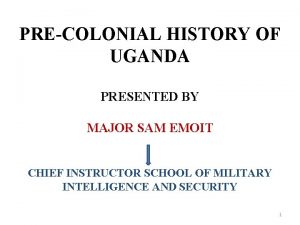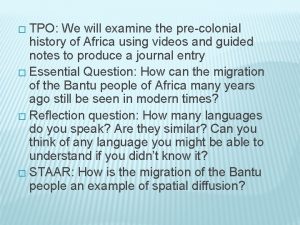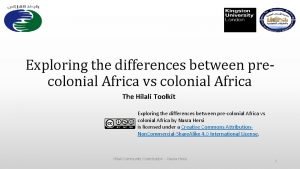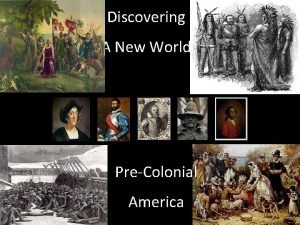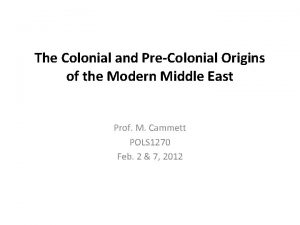PHILIPPINE POLITICAL HISTORY From PreColonial to the PostMartial














![Philippine Colonial Government Royal Audiencia [Judicial, Legislative & Limited Executive Powers] Governor-General [Executive Powers] Philippine Colonial Government Royal Audiencia [Judicial, Legislative & Limited Executive Powers] Governor-General [Executive Powers]](https://slidetodoc.com/presentation_image_h/1166bfb11d2db3dfa8d041b043b11995/image-15.jpg)








































![Definition [T]hat body of rules & maxims in accordance with which the powers of Definition [T]hat body of rules & maxims in accordance with which the powers of](https://slidetodoc.com/presentation_image_h/1166bfb11d2db3dfa8d041b043b11995/image-56.jpg)






- Slides: 62

PHILIPPINE POLITICAL HISTORY From Pre-Colonial to the Post-Martial Law Period

Pre-Colonial Early Filipinos possessed a well-organized political structure even before the arrival of the Spaniards in the 16 th century. Barangays, a Malay word “balangay” which means sailboat, are small self-sustaining communities consisted of 30 to 100 families. Each barangay is independently ruled by a datu, raja, hari, or lakan.

Barangay Government Executive Army Commander Chief Judge Legislator

Barangay Government The position of barangay chieftain is a hereditary position. In the absence of a legitimate son or daughter of the deceased chieftain, the all noble and freemen elect their new chief, on the basis of: 1. 2. 3. Wealth Strength Wisdom.

Barangay Government Aside from the right of the people to choose their new chieftain, in cases necessary, the early barangay government manifested signs of democracy. Albeit the great powers of the datu, they are not absolute. Hence, consultation with the elders or “Maginoo” is required in cases of: � Declaration of war; � Marriage of the lakan or lakambini;

Barangay Government �Entering of Inter-Barangay Alliance; �Passage of new barangay laws; and �Judgment of certain crimes.

Pre-Colonial: Social Classes Maharlikas Timawas Aliping Namamahay Aliping Saguiguilid

Inter-Barangay Relations In order to protect themselves against bigger and stronger barangays, some barangays entered into alliances or confederations. Usually, confederations existed because of: � Military Protection; � Trade; � Marriages of the lakans and lakambinis. Treaties were sealed by the traditional “sandugo” [one blood] or blood compact.

Arrival of the Spanish March 16, 1521, the Portuguese explorer and commander of the Spanish Expedition, Ferdinand Magellan rediscovered the Philippine Islands. March 17, 1521, the expedition first landed on a small uninhabited islet of Homonhon March 18, 1521, the Spaniards first encountered the Filipino natives, bearing bananas, fish, coconuts and palm wine. March 29, 1521, Raha Kolambu & Magellan made the first recorded blood compact between a native & a foreigner.

Arrival of the Spanish March 31, 1521, first Catholic Mass held on the shores of Limasawa[? ] April 7, 1521, Magellan landed on Cebu & made a blood compact with Raja Humabon. April 27, 1521, Magellan fought the forces of Lapu-Lapu and was killed during the battle.

Arrival of the Spanish After the Magellan Expedition, there were five (5) more expeditions to the Orient: 1. 2. 3. 4. 5. Loaisa – 1525 Cabot – 1526 Saavedra – 1527: Reached Mindanao but failed to colonize Villalobos – 1542: Reached Mindanao but failed to colonize. Named Mindanao “Cesarea Caroli” in honor of King Charles I of Spain. Named the Philippines “Islas Filipinas” in honor of then Crown Prince Philip. Legazpi – 1564: Successful colonization.

Arrival of the Spanish February 13, 1565, Legazpi arrived in Cebu. February 22, Legazpi and Datu Urrau of Samar entered into a blood compact. March 9, Legazpi landed in Limasawa and was hospitably received by Datu Bankaw. March 16, Legazpi & Sikatuna entered into a blood compact. After a few days, Legazpi did the same with Sigala. April 27, Legazpi sailed back to Cebu and fought the defiant forces of Raja Tupas, who was defeated by the Spanish forces.

Period of Spanish Colonialism The Philippines was a part of the Viceroyalty of Mexico. After the separation of Mexico from Spain in 1821 and until 1898, our country was directly ruled by Madrid, Spain, through the appointed colonial officers. Being a part of the expansive colony of the Spanish empire, all affairs of the colonies, including the Philippines, were handled by the Council of the Indies.

Period of Spanish Colonialism The Council of the Indies was later replaced by the Ministerio de Ultramar. Minister of Colonies Consejo de Filipinas • Deputy Minister of Colonies • Directors of the Ministry [Ex-Officio Member] • 12 Regular Members appointed by the
![Philippine Colonial Government Royal Audiencia Judicial Legislative Limited Executive Powers GovernorGeneral Executive Powers Philippine Colonial Government Royal Audiencia [Judicial, Legislative & Limited Executive Powers] Governor-General [Executive Powers]](https://slidetodoc.com/presentation_image_h/1166bfb11d2db3dfa8d041b043b11995/image-15.jpg)
Philippine Colonial Government Royal Audiencia [Judicial, Legislative & Limited Executive Powers] Governor-General [Executive Powers] National Residencia [An obligatory accounting of acts of an outgoing Governor-General] Visitador [An envoy sent by the Spanish Crown to investigate Philippine conditions & the complaints against the Governor-General]

Philippine Colonial Government Alcaldia Corregimiento Ayuntamiento Pueblo Barrio

Era of Philippine Revolution Reasons for the early revolutions against Spain: 1. 2. 3. 4. 5. 6. To regain lost freedom & happiness; To fight Spanish oppression; To denounce religious persecution; To struggle against tributes & forced labor; Agrarian disputes; Wine monopoly.

Era of Philippine Revolution Propaganda Movement Kataasan Kagalangang Katipunan ng mga Anak ng Bayan [KKK] Revolution

Propaganda Movement Reforms Desired by the Propaganda Movement 1. 2. 3. 4. 5. Equality of Filipinos & Spaniards before the law. Assimilation of the Philippines as a regular province of Spain. Restoration of Philippine representation in the Spanish Cortes. Filipinization of the Philippine parishes and expulsion of the friars. Human rights for Filipinos.

The Katipunan Founded on the 7 th of July, 1892 at No. 72 Azcarraga St. , Tondo, Manila. Aims of the Katipunan: 1. 2. To unite the Filipinos; and To fight for Philippine Independence through violent revolution.

The Katipunan Government Kataasang Sanggunian President Fiscal Secretary Sangguniang Bayan Sangguniang Balangay Sangguniang Hukuman Treasurer Comptroller

Katipunan Membership Bonifacio Convert Plata Diwa Convert

Bayani Kawal Katipun

The Philippine Revolution August 26, 1896 – The Cry of Balintawak August 30, 1896 – The Battle of San Juan November 9 -11, 1896 – Battles of Binakayan & Dalahican

Magdiwang & Magdalo Councils King Andres Bonifacio President Baldomero Aguinaldo Vice-King Mariano Alvarez Vice-President Edilberto Evangelista Minister of War Secretary of War Minister of Interior Sec. of Interior Minister of Finance Sec. Natural Resources Minister of Natural Resources Sec. Agriculture Captain General Lieutenant General

The Imus Assembly Establishment of a revolutionary government under new elected officials. Uniting the Magdalo & Magdiwang forces under a single command.

The Tejeros Assembly Same objectives of the Imus Assembly. Controversial. Conflict-filled.

Result of the Tejeros Election President Emilio Aguinaldo Vice-President Mariano Trias Captain General Artemio Ricarte Director of War Emiliano Riego de Dios Director of War Andres Bonifacio

Naic Revolutionary Assembly President Emilio Aguinaldo Vice-President Mariano Trias Captain General Artemio Ricarte Sec. Interior Pascual Alvarez Sec. State Jacinto Lumbreras Sec. Finance Baldomero Aguinaldo Sec. of Commerce & Industry Mariano Alvarez Sec. Justice Severino delas Alas Sec. War Emiliano Riego de Dios

Bonifacio’s Execution Bonifacio vs. Aguinaldo in Limbon, Indang, Cavite. May 5, 1897 – Bonifacio Bros. were charged before the Court-Martial May 6, 1897 – the Council of War rendered its decision recommending the death penalty. May 8, 1897 – Aguinaldo commuted the death penalty of death to banishment to an isolated place. May 10, 1897 – Andres & Procopio Bonifacio were executed by firing squad at Mount Hulog,

Biak na Bato Assembly Under the Biak na Bato Asembly, the Biak na Bato Republic was inaugurated and the Biak na Bato Constitution was promulgated. The Constitution was patterned closely after the Cuban Constitution. It was written by Isabelo Artacho & Felix Ferrer. Term of effectivity: Two years only.

It declared that the aim of the revolution was the separation into an independent state. Government was vested to a Supreme Council, headed by a President, Vice. President, & four secretaries. Executive power resided in the President, or in his absence, the Vice-President. Judicial power was vested in a Supreme Council of Grace & Justice.

Official language of the Republic: Tagalog. The Biak na Bato Constitution also contained a Bill of Rights to safeguard the human rights of the people.

Aguinaldo on Exile The Pact of Biaknabato was a peace agreement between the Spanish Governor & General Aguinaldo. It declared the cessation of military actions between the 2 parties & the enactment of reforms and amnesty. In accordance with the Pact of Biaknabato, entered between Governor Primo de Rivera & General Aguinaldo, Aguinaldo ceased all military actions, received in behalf of the Filipino people sum amount of monetary indemnity, and went abroad for exile.

Entry of the Americans to Philippine Soil The Battle of Manila Bay Filipino-American Collaboration

Aguinaldo’s Dictatorial Government When Aguinaldo was on exile, he planned on establishing a Federal Republic of the Philippines. �Mariano Ponce wrote the Constitution in Hong Kong. Upon recommendation & advice, Aguinaldo established a temporary dictatorial government on May 24, 1898.

Proclamation of Philippine Independence June 12, 1898, Kawit, Cavite – the Philippine Independence was proclaimed & the country is to be governed by a dictatorial government. �Formal unfurling of the Filipino Flag; �Playing of the National Anthem; �Reading & signing of the “Act of the Declaration of Independence”.

June 23, 1898 – under the advise of Apolinario Mabini, Aguinaldo changed the dictatorial government into a revolutionary government.

End of Filipino-American Collaboration August 18, 1898 – Manila was “captured” by the Filipino & American forces. Treaty of Paris – Spain ceded the Philippines to the USA for the amount of $20 million.

The Malolos Congress was inaugurated at the Barasoain Church, Malolos, Bulacan. The Congress was able to achieve the following: 1. 2. 3. Ratification of the Philippine Independence; Floating of a domestic loan of P 20, 000. 00 redeemable in 40 years after the date of issue; Promulgation of the Malolos Constitution.

Malolos Constitution 3 Consitutional Drafts: 1. 2. 3. Mabini Plan: Constitutional Programme of the Philippine Republic; Paterno Plan Calderon Plan – the draft which was considered the best and later on approved by the Malolos Congress. January 21, 1899 – Aguinaldo proclaimed the Malolos Constitution as the law of the land

Birth of the Philippine Republic Malolos Republic – The first Philippine Republic �It was the first republic in Asia. �January 23, 1899 �Barasoain Church, Malolos, Bulacan. �It lasted for 2 years, 1 month & 10 days.

America’s Rule “The Philippines are ours, not to exploit, but to develop, to civilize, to educate, to train in the science of selfgovernment. ” – US Pres. Mckinley

Philippine Democratization Military Government The Philippine Commission • The Military Governor governed the country under the direct authority of the US President as Commander-in-Chief of the USAF. • 1898 -1901 • Tasked to make a survey if the Philippine conditions & to achieve the peaceful extension of American sovereignty in the country • Schurman Commission • Taft Commission Civil Government • By virtue of the Spooner Amendment, the authority to govern the Philippines passed from the President to Congress. • Filipinos were given greater participation in the governance of the country. Commonwealth Government • Tydings-Mcduffie Law authorized the Philippine Legislature to call a Constitutional Convention to draft the constitution of the Philippines. • The 1935 Constitution was written, passed, and ratified during this period.

Japanese Occupation Japanese Military Administration • Established on January 3, 1942. • Created for the purpose of supervising the political, economic, & cultural affairs of the Philippines The Philippine Executive Commission • Following the last instructions of Pres. Manuel L. Quezon, the Filipino leaders were forced to “collaborate” with the Japanese in order to save more Filipino lives. Japanese. Sponsored Republic • “Withdrawal” of the Japanese Military Administration • Although Filipinos were occupying the official posts, Japanese “advisers” were always stationed in their offices to supervise.

Independence & the Third Republic Roxas Administration: began the rehabilitation & reconstruction of the war-ravaged Philippines. � Established a pro-American policy. � Supported the Parity Amendment Quirino Administration: continued economic reconstruction of the nation and the restoration of the faith & confidence of the people in the government. � Hukbalahap insurgency grew stronger.

Magsaysay Administration: 1 st President to improve the conditions of the barrios & the indiscriminate slaughter of carabaos. � SEATO was established. � Laurel-Langley Agreement between the Philippines & the US was concluded. It provided for the gradual abolition of free trade between the US and the Philippines. � Reparation Agreement with Japan was signed. It provided that Japan would pay reparations for the destruction committed by the Japanese forces during WWII totalling $300, 000 for 25 years.

Garcia Administration: � strengthened Philippine democracy � revived Filipino culture. � Adopted the “Filipino First” policy to promote greater Filipino participation in business. Macapagal Administration: � the agricultural Land Reform Code was enacted. � Propagation of the Filipino Language. � Independence day was changed from July 4 to June 12. � Officially filed a claim over Sabah, North Borneo. � Formation of Ma. Phil. Indo.

Marcos Administration: � 1 st 1. 2. 3. 4. Term Stabilization of government finance Greater production of rice by promoting the cultivation of “miracle rice”, the construction of more irrigation systems & giving financial & technical assistance to the farmers. Building of more roads & bridges, school houses & other public works. Intensive drive against smuggling, crime syndicates, and the communist NPA.

� 2 nd Administration Problems: 1. Prevalence of dirty politics 2. Rampage of graft & corruption 3. Widening gap between the rich & the poor 4. Impotency of the 1935 Philippine Constitution to cope with the new socioeconomic problems of the times 5. Rising tide of communism, crime & subversion.

Martial Law Regime 9: 00 pm September 22, 1972 – Proclamation 1081 was implemented. 1973 Constitution was finally passed, adopted, & ratified. 1. 2. 3. 4. 5. Establishment of a Parliamentary Government. Legislative power was vested in a unicameral National Assembly. Emphasis on the duties & obligations of citizens, as well as their rights & duty to vote. Parity rights was terminated. Marcos was given the power to legally exercise legislative powers & his term was to be extended beyond 1973.

The New Society The conquest of mass poverty & the democratic distribution of wealth & property. Land reform is considered as the greatest achievement of President Marcos under martial law. National Economic Development Authority (NEDA) was established. Tax reforms were implemented quadrupling the government revenue from Php 5. 3 Billion to Php 19. 2 Billion.

January 17, 1981 – Proclamation 2045, ended the 8 years & 4 months of martial law in the Philippines. June 30, 1981 – Marcos inaugurated the “New Republic”, history-wise is the 4 th Philippine Republic.

Restoration of Democracy in the Philippines Vox populi, vox dei. During the transitory government of Aquino, she promulgated the Provisional Constitution of the Republic of the Philippines or the “Freedom Constitution”. June 2, 1986 – Constitutional Commission for the framing of a new Constitution was created. February 2, 1987 – Constitution was ratified by the people.

CONCEPT OF THE CONSTITUTION
![Definition That body of rules maxims in accordance with which the powers of Definition [T]hat body of rules & maxims in accordance with which the powers of](https://slidetodoc.com/presentation_image_h/1166bfb11d2db3dfa8d041b043b11995/image-56.jpg)
Definition [T]hat body of rules & maxims in accordance with which the powers of sovereignty are regularly exercised. (Cooley, as cited by I. Cruz, Consti. Law)

Purpose 1. 2. 3. To prescribe the permanent framework of a system of government; To assign to the several departments their respective powers & duties, & To establish certain first fixed principles on which government is founded.

Supremacy of the Constitution The Constitution is SUPREME. �No act shall be valid, however noble its intentions, if it conflicts with the Constitution. [Supremacy of the Constitution must prevail. ]

Classification Written Unwritten Evolved Enacted Rigid Flexible

Written Conventional Rigid

Essential Qualities of the Written Constitution Brief Broad Definite Constitution

Essential Parts of the Written Constitution of Government Constitution of Sovereignty Constitution of Liberty Constitution
 Arquitectura precolombina en honduras
Arquitectura precolombina en honduras Relationship between political science and sociology
Relationship between political science and sociology Political science and economics relationship
Political science and economics relationship Sample of political cartoon
Sample of political cartoon Hình ảnh bộ gõ cơ thể búng tay
Hình ảnh bộ gõ cơ thể búng tay Bổ thể
Bổ thể Tỉ lệ cơ thể trẻ em
Tỉ lệ cơ thể trẻ em Chó sói
Chó sói Chụp tư thế worms-breton
Chụp tư thế worms-breton Alleluia hat len nguoi oi
Alleluia hat len nguoi oi Môn thể thao bắt đầu bằng từ chạy
Môn thể thao bắt đầu bằng từ chạy Thế nào là hệ số cao nhất
Thế nào là hệ số cao nhất Các châu lục và đại dương trên thế giới
Các châu lục và đại dương trên thế giới Công thức tính thế năng
Công thức tính thế năng Trời xanh đây là của chúng ta thể thơ
Trời xanh đây là của chúng ta thể thơ Mật thư tọa độ 5x5
Mật thư tọa độ 5x5 Phép trừ bù
Phép trừ bù độ dài liên kết
độ dài liên kết Các châu lục và đại dương trên thế giới
Các châu lục và đại dương trên thế giới Thể thơ truyền thống
Thể thơ truyền thống Quá trình desamine hóa có thể tạo ra
Quá trình desamine hóa có thể tạo ra Một số thể thơ truyền thống
Một số thể thơ truyền thống Cái miệng bé xinh thế chỉ nói điều hay thôi
Cái miệng bé xinh thế chỉ nói điều hay thôi Vẽ hình chiếu vuông góc của vật thể sau
Vẽ hình chiếu vuông góc của vật thể sau Nguyên nhân của sự mỏi cơ sinh 8
Nguyên nhân của sự mỏi cơ sinh 8 đặc điểm cơ thể của người tối cổ
đặc điểm cơ thể của người tối cổ V cc
V cc Vẽ hình chiếu đứng bằng cạnh của vật thể
Vẽ hình chiếu đứng bằng cạnh của vật thể Fecboak
Fecboak Thẻ vin
Thẻ vin đại từ thay thế
đại từ thay thế điện thế nghỉ
điện thế nghỉ Tư thế ngồi viết
Tư thế ngồi viết Diễn thế sinh thái là
Diễn thế sinh thái là Dot
Dot Số nguyên tố là gì
Số nguyên tố là gì Tư thế ngồi viết
Tư thế ngồi viết Lời thề hippocrates
Lời thề hippocrates Thiếu nhi thế giới liên hoan
Thiếu nhi thế giới liên hoan ưu thế lai là gì
ưu thế lai là gì Hổ đẻ mỗi lứa mấy con
Hổ đẻ mỗi lứa mấy con Sự nuôi và dạy con của hổ
Sự nuôi và dạy con của hổ Hệ hô hấp
Hệ hô hấp Từ ngữ thể hiện lòng nhân hậu
Từ ngữ thể hiện lòng nhân hậu Thế nào là mạng điện lắp đặt kiểu nổi
Thế nào là mạng điện lắp đặt kiểu nổi What is pept
What is pept Stylistic overview
Stylistic overview Philippine statistics authority
Philippine statistics authority Pnp badge
Pnp badge Ang pilipinas ay binubuo ng mga
Ang pilipinas ay binubuo ng mga Difference between ncbts and ppst
Difference between ncbts and ppst Land of the morning child of the sun returning
Land of the morning child of the sun returning Karagatan theater
Karagatan theater He is the foremost filipino abstract painter
He is the foremost filipino abstract painter Examples of zarzuela in the philippines
Examples of zarzuela in the philippines Period of activism 1970 to 1972
Period of activism 1970 to 1972 He is the father of modern philippine sculpture
He is the father of modern philippine sculpture Father of philippine pharmacophytology
Father of philippine pharmacophytology Disadvantages of termites
Disadvantages of termites Philippine oral lore
Philippine oral lore D-ncbts
D-ncbts Philippine grid code
Philippine grid code

